Lactose-Free Dairy Market Research, 2031
The global lactose-free dairy market size was valued at $11.45 billion in 2021, and is projected to reach $24.36 billion by 2031, growing at a CAGR of 8% from 2022 to 2031.
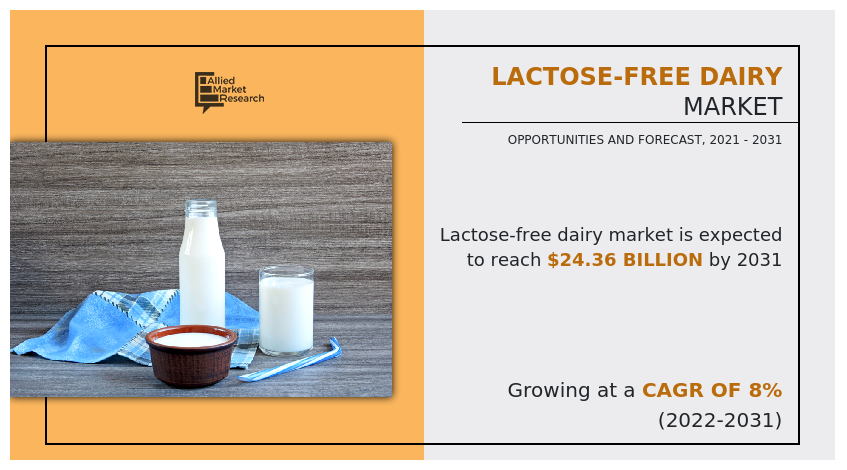
Lactose-free dairy is a commercial product made from lactose-free milk. Lactose is a kind of sugar found in milk that some people find difficult to digest. Lactose-free dairy products are made by combining lactase with regular cow milk. Lactase is an enzyme that is spontaneously produced in the small intestine of an individual and is responsible for the breakdown of lactose in the body. It is a commercially available enzyme that may be isolated from yeasts such as Kluyveromyces fragilis and Kluyveromyces lactis, as well as molds such as Aspergillus niger and Aspergillus oryzae. Lactose-free dairy products have a taste, texture, and nutritional profile identical to ordinary milk and milk products in the market.
Intense competition in the lactose-free dairy market has encouraged market players to focus on strong branding and improved advertisements to attract the interest of the consumer. Branding and advertisement play a vital role in gaining consumer cognizance regarding the products. As a result, players are venturing into lucrative marketing campaigns to lure consumers. Furthermore, an increase in product launches of lactose-free dairy products fortified with vitamins and minerals attracts consumers to opt for the product. Strong branding by the market players and the introduction of clear labels on the products help the consumers to identify the ingredients used in the product and the benefits they can get from the consumption of the product. For instance, in 2022, Chobani Ultra-Filtered Milk, a lactose-free, protein-rich ultra-filtered milk, was introduced by Chobani LLC. Chobani Ultra-Filtered Milk is prepared with a unique filtering process that removes lactose and cuts sugar in half. It has a thick and creamy texture, is high in calcium and vitamin D, and contains all nine necessary amino acids. Clear branding and new product launches attract consumers and enhance the lactose-free dairy market growth.
The lactose-free dairy market is segmented on the basis of type, form, distribution channel, and region. On the basis of type, the market is categorized into milk, cheese, yogurt, and others. On the basis of form, it is segregated into solid, liquid, and powder. On the basis of distribution channel, it is divided into hypermarkets/supermarkets, convenience stores, online channels, and others. On the basis of region, it is analyzed across North America (the U.S., Canada, and Mexico), Europe (Germany, the UK, France, Italy, Spain, and Rest of Europe), Asia-Pacific (China, India, Japan, Australia, South Korea and Rest of Asia-Pacific), and LAMEA (Brazil, Turkey, South Africa, Argentina, and Rest of LAMEA).
On the basis of product type, the milk segment gained a major share in the global lactose-free dairy market in 2021 and is expected to sustain its market share during the forecast period as milk is the most common form of lactose-free dairy that is used by the global population for consumption.
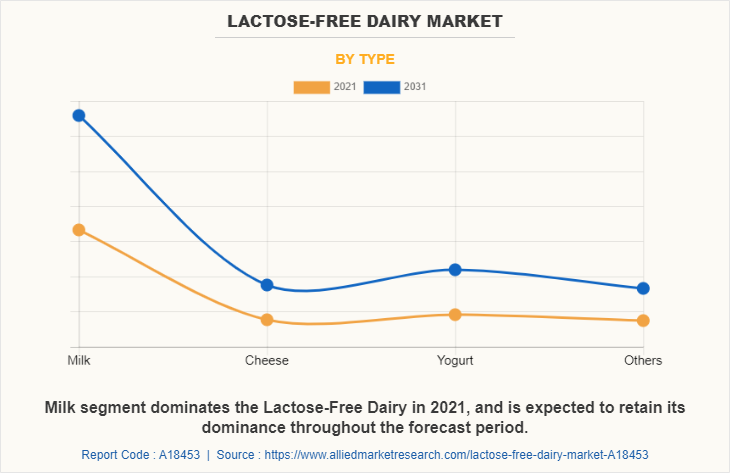
On the basis of form, the liquid segment gained a major share in the global market in 2021 and is expected to sustain its market share during the forecast period. The liquid is the most common form in which lactose-free dairy is available in the market. The global consumption of milk in liquid form is the highest and it is an important part of the daily diet of the consumer.
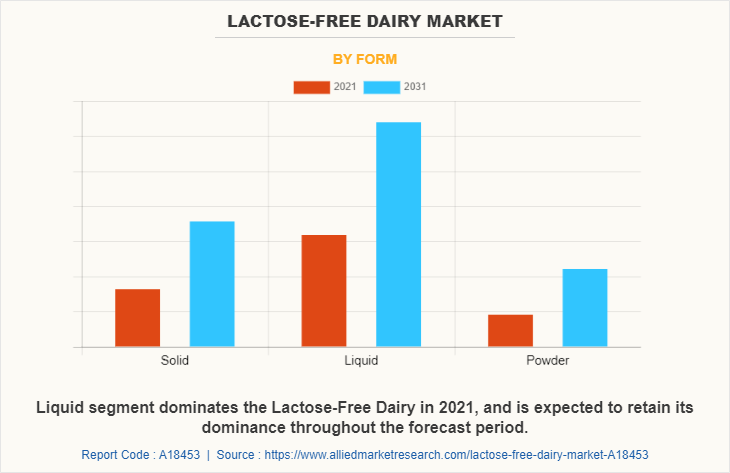
On the basis of distribution channel, the hypermarkets/supermarkets segment accounted for around 35% of the global lactose-free dairy market share in 2021 and is expected to sustain its share during the forecast period. Hypermarkets/supermarkets offer a convenient experience of diverse shopping under a single roof to the consumers. Hypermarkets/supermarkets provide the consumers a premium advantage, i.e., higher availability of lactose-free dairy products at discounts, the assistance of sales representatives, and easy checkouts. These advantages are expected to drive the growth of hypermarkets/supermarkets during the forecast period.
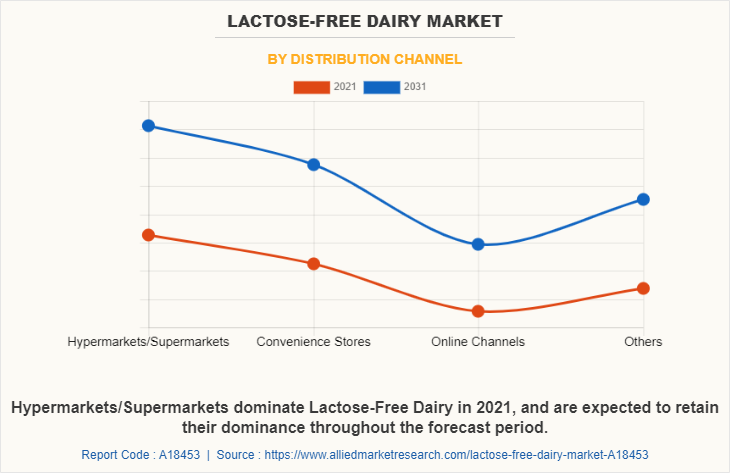
On the basis of region, Europe dominated the lactose-free dairy market in 2021 and is expected to remain dominant during the lactose-free dairy market forecast period. The dominance of the lactose-free dairy market is largely due to the deep product knowledge among the consumers and increase in consumption due to its health benefits in the Europe region
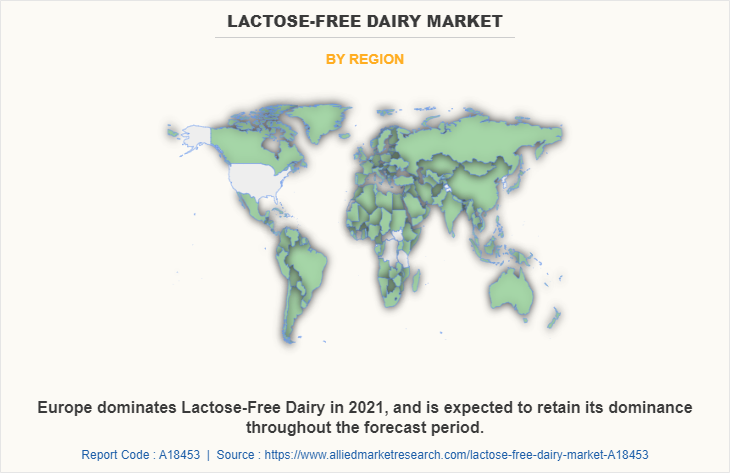
The players operating in the global lactose-free dairy industry have adopted various developmental strategies to expand their lactose-free dairy market size, increase profitability, and remain competitive in the market. The key players profiled in this report include Arla Foods amba, Danone S.A., General Mills, Inc., Gujrat Cooperative Milk Marketing Federation (AMUL), Johnson & Johnson Services, Inc., Lifeway Foods, Inc., Nestle S.A., Organic Valley, Saputo, Inc., and Smithfoods, Inc. Some of the additional companies in the lactose-free dairy business include Agri Mark, Inc., Fonterra Group, Lala U.S., The Kraft Heinz Group, Prairie Farms Dairy, The Coca-Cola Company, and others.
Key Benefits For Stakeholders
- This report provides a quantitative analysis of the market segments, current trends, estimations, and dynamics of the lactose-free dairy market analysis from 2021 to 2031 to identify the prevailing lactose-free dairy market opportunity.
- The market research is offered along with information related to key drivers, restraints, and opportunities.
- Porter's five forces analysis highlights the potency of buyers and suppliers to enable stakeholders make profit-oriented business decisions and strengthen their supplier-buyer network.
- In-depth analysis of the lactose-free dairy industry segmentation assists to determine the prevailing market opportunities.
- Major countries in each region are mapped according to their revenue contribution to the global market.
- Market player positioning facilitates benchmarking and provides a clear understanding of the present position of the market players.
- The report includes the analysis of the regional as well as global lactose-free dairy market trends, key players, market segments, application areas, and market growth strategies.
Lactose-Free Dairy Market Report Highlights
| Aspects | Details |
| By Type |
|
| By Form |
|
| By Distribution Channel |
|
| By Region |
|
| Key Market Players | Nestle S.A., Johnson & Johnson Services, Inc., Organic Valley, Gujrat Cooperative Milk Marketing Federation (AMUL), Danone S.A., General Mills, Inc., The Kroger Company, Lifeway Foods, Inc., Arla Foods AMBA, Saputo, Inc. |
Analyst Review
Various CXOs from leading companies perceive that the Asia-Pacific region has the most lucrative growth opportunities. Lactose intolerance is a serious issue in the Asia-Pacific region as the rate of lactose intolerance in consumers is 2.5 times higher than that of consumers living in the European region. Moreover, lactose intolerance is not the sole reason for lactose-free products to flourish in the Asia-Pacific region. The rise in health consciousness among Chinese customers is depicting the adoption of lactose-free dairy products. The growing knowledge about the importance of lactose-free dairy products is also anticipated to contribute to market growth. In addition, the manufacturing companies are looking forward to manufacturing products of a different flavors to elevate the taste of the product and provide a valuable experience for the customers.
CXOs further added that according to National Geographic, 18 billion pounds of plastic flow into the ocean every year, and only 9% of the total plastic produced has been recycled. Also, 79% of it is currently dumped into landfills or discarded in the natural environment. Therefore, there is a need for sustainable packaging of dairy products including cheese, which in consequence has led many key players to step toward eco-friendly and sustainable packaging options.
A global paper packaging group named Mondi and Hazeleger Kaas Company has entered into a partnership to promote sustainable packaging of cheese. By working together, they have produced cheese packaging with PP thermoforming top and bottom web, and PP label so that the packaging can be entirely recycled, which was not possible previously. Therefore, sustainable packaging is projected to shape the future packaging of cheese and other dairy products due to the surge in environmental concerns.
The global lactose-free dairy market size was valued at $11,451.5 million in 2021, and is estimated to reach $24,363.3 million by 2031, registering a CAGR of 8.0% from 2022 to 2031.
The global lactose-free dairy market registered a CAGR of 8.0% from 2022 to 2031.
Raise the query and paste the link of the specific report and our sales executive will revert with the sample.
The forecast period in the lactose-free dairy market report is from 2022 to 2031.
The top companies that hold the market share in the lactose-free dairy market include Arla Foods amba, Danone S.A., Nestle S.A., Saputo, Inc., and Smithfoods, Inc.
The lactose-free dairy market report has 3 segments. The segments are product type, form, and distribution channel.
The emerging countries in the lactose-free dairy market are likely to grow at a CAGR of more than 12% from 2022 to 2031.
Post COVID-19, the ease of lockdown had improved the supply chain for lactose-free dairy products and with the increasing lactose intolerant population in the Asia-Pacific and North America region.
Europe will dominate the lactose-free dairy market by the end of 2031.
Loading Table Of Content...



